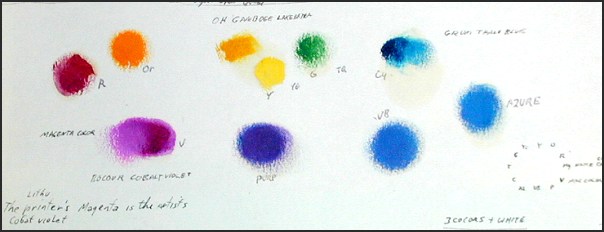Post by Admin on Dec 26th, 2009 at 11:55am
There was a time when the color, PR122 magenta was not available and alizarin crimson was the best we had. In 1900 O.H. had the only copy of the original Indian yellow, in 1990 it was special order and in oil only. We did have cyan pathalocyanine. This was around 1963 and Bocour had a magenta color that was better color than alizarin. That was the best primary triad we had.
The problem with the cobalt phosphate (a cool magenta) was that it bleed through layers of oil paint and had to be isolated. I still have the original tube of color. This color was discontinued when Bocour New York was sold.
Than we got PR:122 and Liquitex made a color called Acra Violet (1975 or so). Now we had an acrylic magenta and cyan but no acrylic transparent yellow. I made my own from a dry pigment in 1995 from a pre 1900 mural restoring company called Zecchi in Florence. Today the best transparent Indian yellow is PY153 dioxine nickel complex + PR 260 isoindolin = Indian Yellow Golden and PY153 dioxine nickel complex + PY150 Nickel Azo Complex for the brown side Indian yellow for oil paints and PY100, Tartrazine, for w/c and acrylics.
http://www.realcolorwheel.com/indianyellowtobrownPY153.htm
Today there is another new kid on the block, Opera. It is more permanent than Alizarin but not as permanent as Sennelier's dry pigment magenta, Quinacridone Red, #679, PR:122. Opera makes the brightest reds and purest blues but won't make the dark magenta, so you still need both colors.
Today we have a complete set of transparent primary colors in dry pigments plus oil and acrylic paints. The best primaries the world has ever known.
Bellini makes a lead chromate and since we don't use sulfur based color anymore it does not turn brown.
Today lead chromate is not available, vanadate lemon is a replacement but not as cool, opaque or as light.
*
Hi Don,
I looked at the reference page that you posted. You state that the most painterly medium is 75% damar with beeswax and that it doesnt yellow. How could this be? That goes against everything that I read about damar. I enjoy the smell and feel of damar and I use a lot of it in my encaustic work, but I need to know why your claims of non-yellowing run contrary to everything else that I read on AMIEN.
Sincerely,
Chad
Hi Chad,
Stop going by just what you have read and test things yourself.
I made a test of all the oils I could buy, all the damars available, all the balsams the turps and the mineral sprits.
Five years later I posted my results, 10 years later I posted.
All oils yellow, damar doesn't. The best damar crystals are from a Greek island called Chios, make your own.
Turpentine is the best thinner for oil paints, I don't agree with Mayer's Handbook saying that petroleum distilled paint thinner works for fine artwork, unless you are talking about alkyds. Mineral sprits work well with them.
1994 tests show Stand Oil and Alkyd were the worst yellow offenders. Cobalt driers were the very worst.
http://www.realcolorwheel.com/oilyellow.htm
So where does that leave you?
Expand your pigment with glass micro-beads, that will reduce the percentage of oil in your paint and give depth to your painting. These glass additives were discovered in ancient paint (Titian) by the Smithsonian.
We were weaned off lead paints because they were poisonous, nonsense, today's chemical pigments are much more poisonous. Check out dioxine purple if you want to see poisonous. We were weaned of lead paint to make room for petroleum pigments. Church-Ostwald did the dirty work in 1916. They also put the spear in transparent colors. All the good painters were dead and the wars kept killing. The importance of transparent colors was not passed on.
Today big-petrol is trying to wean us off of turpentine and they have to destroy damar because it only works with turpentine.
Well I have other news for you, mineral spirits leave behind a mold and it does not dry faster than turp. and it's more poisonous. Do your own tests and research.
http://www.realcolorwheel.com/gamsol.htm
The only problem with damar and wax is the final dried paint can be scratched but it won't crack or yellow.
If you do encaustic work, have you tried the Egyptian paint, cera cola? It's a water based wax paint made by adding ammonia. It dries insoluble to water. This is the medium of the Egyptian Fayian grave paintings.
http://www.realcolorwheel.com/caracola.htm
I think the best all around medium is fresco, but it's fragile. It paints better, faster and is the most permanent.
http://www.realcolorwheel.com/fresco.htm
These are the three primaries in watercolors, PY150, PR122 and PB15. The yellow has a little magenta on it from when I was painting this example.

